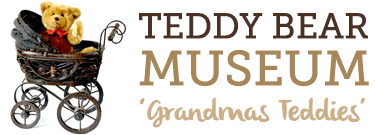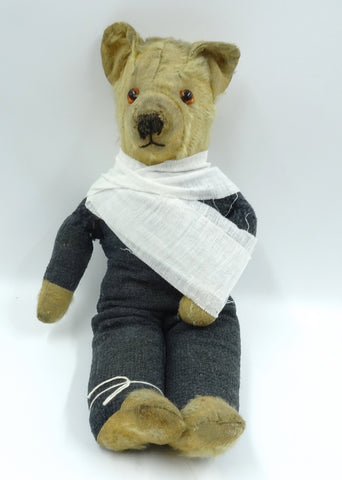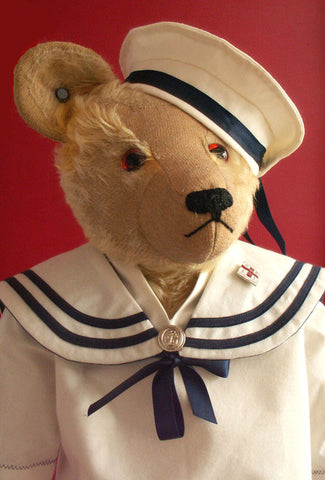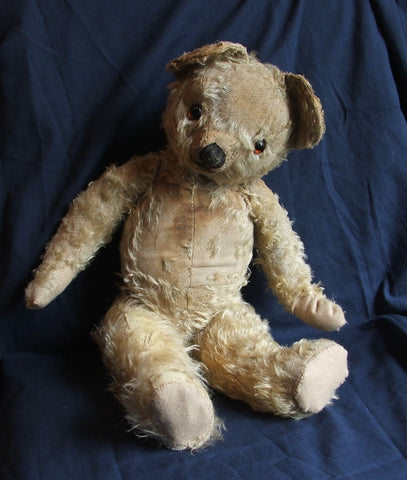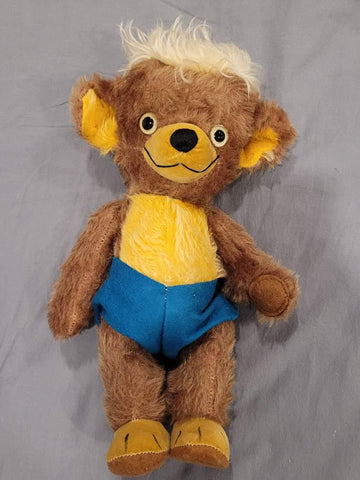Merrythought
Merrythought was established in 1930 and brought in Clifton Rendle of Chad Valley and Henry Janisch of J. K. Farnell (two leading British soft toy manufacturers) as sales personnel and together with talented designer Florence Attwood produced the company’s first catalogue. Merrythought was the 17c name for "Wishbone", the symbol for good luck, which features on their button and label. Further details below
Merrythought bears identifying features are:-
- Ears set wide apart and sewn into facial seam flat.
- shaved muzzle
- wood wool stuffed head
- Wishbone button in ear in early bears
- vertically stitched nose with downward outer stitches
- webbed claws
- label on foot of early bears
Bears with buttons have "A Wishbone" before their name so that their photos sit together.
Similarly those with Labels say so.
Further details
History: Merrythought is the oldest family owned soft toy company. In 1919 William G. Holmes and G.H. Laxton opened a small spinning mill in Oakworth, Yorkshire called ‘Holmes & Laxton and Co’ to weave yarns from imported raw mohair. This soon proved to be too small so the new business took over a weaving factory in Huddersfield in 1920.
The next few years were spent consolidating and expanding. In 1930 they purchased mohair-plush weaving factory ‘Dyson, Hall and Co’, to secure the teddy bear mohair plush fabrics. They founded a soft toy company ‘Merrythought’ with 20 workers, manufacturing began in a temporary premises in September 1930. In February 1931 they leased one of the buildings at Coalbrookdale (now Ironbridge) in Shropshire and hired more staff (almost 200 by 1932), just a few miles from the Chad Valley factory in Wellington. They recruited the Clifton J. Rendle as head of production, formerly of Chad Valley Toy Company, and Henry C. Janisch, who had headed up sales for Britain’s oldest soft toy maker, J. K. Farnell. Also a number of employees made the move with Rendle from Chad Valley.
Electric motors were installed for power driven sewing machines. There were storage sheds for stuffing, packing cases and crates while stockrooms contained completed and packed soft toys. By 1935 Merrythought was the largest soft toy factory in the UK. Their bears reflected the rounder, cuddlier character of British bears. The smiling expression and childlike eyes of Merrythought bears made them very popular.
In 1939 with the advent of WWII, the British Admiralty instructed the factory to undertake map-making work, chevrons, helmet linings, igniter bags, gas mask bags and hot water bottle bags. It also continued to manufacture a few soft toys at a temporary premises at nearby Wellington. It wasn’t until 1946 were they able to properly resume soft toy production, despite shortage of supplies and components. Plus the River Severn flooded the factory which destroyed all pre-war samples and many supplies but they still managed to produce a small range of teddy bears and animals.
The emergence of Britain’s new style teddy bear with shorter arms, a straight back, and a mix of kapok and wood wool stuffing distinguished them from early American or German bears of this period. A new American compressed-air stuffing machine was introduced in 1955, while hydraulic press cutters were later installed. Every process and component are subject to stringent quality and safety checks. Fabrics are tested for flammability. Eyes and other non-pliable components are ‘locked’ into position.
Florence Atwood: Florence Attwood was the daughter of one of Chad’s founders, she gained experience working with Norah Wellings at Chad Valley. Florence attended the Deaf and Dumb School in Manchester where she learnt the craft. A classmate of hers was Mr. Rendle’s daughter. Initially she designed a range of 32 soft toys which included animals, play toys and dolls, alongside the original traditional teddy bear and Magnet bear. Florence was their chief designer who created all the patterns until her death in 1949. She created bears from her own designs and also from other artists work i.e. Lawson Wood’s caricatured orang-utan, Gran’Pop. She designed Merrythought’s first panda following the arrival of Ming at the London Zoo in 1939.
Product Designs: Traditional Merrythought Bear: was created in 1931 and has continued to be been manufactured to current day. His characteristics were large slightly cupped flat ears are centred over facial seams. Translucent amber and black glass eyes on wire shanks sewn into the face, set wide apart and low down emphasising a prominent forehead. A pronounced shaved muzzle (emulates the traditional realistic Steiff design), and two outer stitches of his nose protrude downwards, the mouth an inverted shallow ‘Y’ shape. A fully jointed bear. A printed celluloid-covered metal button included a wishbone, in the ear or sometimes on the back of the body. Relatively long arms, curved arms. Wool felt paw pads were shaped so that the straight end of the felt is cut on the diagonal. Feet could be made from wool felt, cotton or velveteen. Webbed claws across the pads, the four black claws are joined by three interconnecting stitches. Straight back, chunky legs (fat thighs are typical of British bears of this period) with small, rounded feet. Most bears were made in a luxurious curly golden mohair plush with a fairly long pile but a dark brown tipped, biscuit coloured mohair was produced 1936-38. The bears were stuffed with wood wool in the head and around the squeaker, the body a mix with kapok, apart from the limbs which were just kapok. Their embroidered label was machine stitch attached to the footpad, which after the WWII changed to a printed label. The effects of rationing impacted on the quality and quantity of the plush fabric. This design was manufactured in 10 sizes and was their key pattern and named the ‘M’ line.
This bear was also made in different colours in artificial silk (rayon) – Eglantine, Azure, Nil, Mimosa, Venus and Clematis. These were advertised as the ‘1932 selections of the Paris Dress Designers’ when teddies were considered to be fashion accessory as well as a child’s toy.
1930’s Alternative Teddy Design: (my Philip bear) some still had the celluloid-covered button on the back behind the left arm joint. Woven embroidered label machine stitched to a foot pad. Bulbous brown and black glass eyes. Rectangular, vertically satin stitched nose, without the dropped outer stitches, double stitched inverted ‘Y’ stitched mouth. Slender torso, curved arms with thin paws. Beige woven twill paw pads, five claws on paws (into the fur) and four on the footpads (into the fur only). Short legs with slight stumpy feet.
Glove Puppets: Since early 19th century the teddy bear has been a popular subject for glove puppets. The teddy bear has a partially hollow head on an empty body. Arms are attached to the body but empty too. Fingers are placed into the head and arms to manipulate gestures. Merrythought made a panda and teddy bear glove puppets but they did not appear in their catalogues.
Magnet Bear: this line of bears in four sizes was aimed to attract the cheaper end of the market. Named with the phrase “the bear which attracts.” A chunky bear with sturdy legs and large ears. At this time this bear was part of a series of floral-scented bears which included Peach Blossom and Petal Rose.
Bingie Bears: In 1931-38 there was a seated Bingie bear cub. Shortly afterwards they introduced a very different Bingie range (1931-38) – dressed bears and undressed bears which included a Guardsman, a Highlander (1925) and a Sailor, all very popular. It is very rare nowadays to find one in his original outfit. In 1972 a London Guardsman and a Policeman were direct descendants of the earlier dressed Bingie bears. The trademark label was attached to the inside of the lower left leg.
Print Teddy: new designs had a mohair head but a body of a heavy cotton print, apparently made for export.
1935 Merrythought produced a bear with a button in the ear, wearing a red jersey to make him look like Winnie-the-Pooh.
Punkinhead Bear: was made for Eaton’s Department store in Canada (1949-1956) in 9” / 16” / 26” heights, he was fully jointed, a long tuft of hair on his head, plus a smiley velvet mouth and feet, made of brown mohair and a contrasting lighter colour chest, inner ears and front paws. The front paws are turned slightly down and the feet large and flat enabling him to stand unaided. He was designed by Florence and Eaton marketed him as Santa’s helper who longed to be part of the Canadian Christmas parade. They distributed story booklets of the little bear’s adventure plus included him in their Christmas promotions. He is also known as “Punkie” and quite collectable.
Giant Panda: In 1939, Merrythought designed a very special Giant Panda for London Zoo. This life-sized soft toy panda acted as a stand-in for London Zoo’s own famous Giant Panda, Ming, during various topical films about her species.
Cheeky Bear: is a distinctive style of teddy bear created by designer Jean Barber in 1955. Appearing in 1957, then named simply ‘Teddy T’, this smiley bear was described as ‘a completely new bear – Tubby Teddy - very soft stuffed with amber eyes and growls’. It is said that at The British Industries Fair, the late Majesty The Queen was introduced to this new ‘Teddy T’, and is said to have exclaimed ‘what a cheeky little bear!’.
Cheeky bears have bells in their large floppy ears, a beak like velveteen muzzle and plastic safety eyes, felt paws, a large circular head that looks too big for the body. The first Cheeky bears were made in gold mohair or a fine beige artificial silk plush, but by the 1960’s they were made in artificial sheepskin and a range of pastel colours and shades of gold and brown. Modern examples are made in mohair or acrylic. Most bears are jointed but some have fixed limbs and a cotton fabric body, which gives the appearance of wearing clothes. This bear proved so popular that many different models were made including a PJ case, and the bendable Mr. and Mrs. Cheeky Twisty (1966-88). Limited editions are still made today.
Disney Characters: were produced as far back as 1953 including Donald Duck, Mickey Mouse, Pluto, Lady and the Tramp, Bambi, and Thumper. A complete set of A. A. Milne’s characters which appeared in a Disney film, which included Kanga, Roo (sat in Kanga’s pocket), Piglet, Eeyore and Pooh (1966). Other well-known characters were Harry Corbett’s Sooty (early 1960’s) and Yogi Bear (1961-64 and early 1970’s).
Mr. Whoppit: (1956) was the mascot of land and water speed record breaker Donald Campbell. His little bear, was always at his side in the cockpit of the Bluebird K7 hydroplane boat. In 1967 he tried to become the fastest man across the water but only Mr Whoppit emerged from the wreckage, intact due to the kapok allowing him to float to the surface. Merrythought reissued a limited production of 5000 replicas of Mr. Whoppit in 1992. Mr. Whoppit was one of three characters from the Robin comic, produced as soft toys in the mid 1950’s.
Limited Editions: During the 1970’s and 1980’s a number of collector’s bears were created and sold through British retailers i.e. Harrods, and also distributed across new export markets, including the United States and Japan. In 1982, a range of limited edition mohair bears were produced for a US importer, Tide-Rider. John Axe’s 1986 company history book inspired the first replica – the Magnet bear; also and illustrations by Prue Theobald, heralding a new era of exclusive collectables. In 1988 Merrythought opened a shop and a museum. In 1990 to celebrate Merrythought’s Diamond Jubilee they made a Jubilee bear. Also a lavender tipped version of the Magnet bear in 1990. Their international Collectors Club was formed in 1995 and worldwide members were united by newsletters, an annual Open Day, and the opportunity to buy a limited edition Club bear every year.
In 1996 an Alpha bear replica of a 1930’s Farnell was limited to 500 production run. There are also bears that commemorate occasions such as the Olympic Games, Royal Weddings and babies plus the late Queen Elizabeth’s 90th birthday (2016). Merrythought collaborated with a number of luxury brands. Film producer Fox contracted them to make a Winnie-the Pooh bear for their film “Goodbye Christopher Robin” (2017) as Merrythought has owned the Farnell brand for many years so they were able to produce a replica of the original bear bought by A. A. Milne from Harrods.
In 2017, an authentic replica of the ‘Traditional Merrythought Bear’ was recreated using the original patterns. The bear was brought to life in celebration of the Royal Mail’s ‘Classic Toys’ stamp series.
Beefeater Bear: produced in 1973 and then again in 1988. He was 18” tall, a mohair head and front paws, the body, limbs and feet are dressed in the traditional Beefeater costume. The costume formed part of the body structure. Ears positioned quite high on the head. The later version had jointed feet and head. They were tagged on the footpad.
Master Mischief (1992) a 14 inch golden mohair bear dressed in short, patched dungarees, and holding a catapult behind his back limited to 1500.
Marking: In 1930 Merrythought registered their trademark. Merrythought is a 17th century old word for ‘wishbone’, a symbol of good luck or a hope fulfilled. This could be found on their yellow celluloid button (in the early years) and later on swing tags. Sometimes the celluloid is missing leaving a blank metal button. The button trademark was phased out but bears have a brand label stitched on the footpad. The embroidered woven label changed to printed label. The very first iron bridge (1779) is near the Merrythought factory, and its shape is echoed in the design of the word ‘Merrythought’ on the labels. In 1957 a redesigned label replaced “Hygienic Toys” with
Some bears are for sale:- Please use the search box. "Merrythought For Sale"
